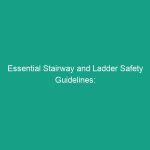Introduction
Good morning team! Today, we are going to discuss an important topic that can significantly impact our health and Safety at work: radon gas. This Toolbox Talk will provide you with essential radon gas guidelines to protect your health and avoid risks associated with exposure. Understanding radon gas is crucial, as it can pose serious health risks if not managed properly. Let’s dive in!
Understanding Radon Gas
Radon is a naturally occurring radioactive gas that can seep into buildings through cracks and gaps in floors and walls. It is colorless, odorless, and tasteless, making it difficult to detect without specialized equipment. The importance of understanding radon gas lies in its association with lung cancer; it is the second leading cause of lung cancer after smoking. For employees working in environments where radon may be present, awareness and proactive measures are vital.
Many people believe that radon gas is not a concern in certain areas, but it can be found in homes and buildings all over the world, regardless of location. This misconception can lead to inadequate Safety Measures and increased health risks.
Key Hazards, Risks, and Safety Considerations
Radon gas exposure can lead to serious health issues, primarily lung cancer. According to the U.S. Environmental Protection Agency (EPA), radon is responsible for about 21,000 lung cancer deaths each year in the United States alone. The key Hazards associated with radon include:
- Long-term exposure: Prolonged exposure to radon gas can significantly increase the risk of developing lung cancer, especially in individuals who smoke.
- Inhalation: Radon gas can enter the lungs when inhaled, causing damage to lung tissue over time.
- Accumulation: In poorly ventilated areas, radon can accumulate to dangerous levels.
Ignoring safety protocols related to radon can have real-world consequences. For example, employees working in basements or poorly ventilated spaces are at higher risk if radon levels are not monitored and managed effectively.
Best Practices, Procedures, & Actionable Advice
To protect yourself and your coworkers from radon exposure, follow these Best Practices:
- Test for radon: Regularly test your workplace for radon levels, especially if you work in a basement or ground-level area. Radon testing kits are available and easy to use.
- Improve ventilation: Ensure adequate ventilation in workspaces to help disperse radon gas. This can include opening windows, using fans, and installing ventilation systems where necessary.
- Seal cracks and gaps: Check for and seal any cracks or gaps in floors and walls that could allow radon to enter the building.
- Implement radon mitigation systems: If testing reveals high radon levels, consider installing a radon mitigation system that can effectively lower radon concentrations in the workplace.
For example, a recent incident in a local office building revealed dangerously high radon levels. Upon testing, it was found that the building’s ventilation system was inadequate. After implementing better ventilation and sealing cracks, radon levels decreased significantly, showcasing the effectiveness of these Best Practices.
Regulations, Standards, and Compliance
Understanding the Regulations surrounding radon gas is crucial for compliance and safety. The EPA provides guidelines for radon levels in homes and workplaces, suggesting that action be taken if radon levels exceed 4 pCi/L (picocuries per liter). Additionally, many states have their own regulations regarding radon testing and mitigation.
Compliance with these regulations is critical not only for legal reasons but also for protecting employee health. Organizations that fail to address radon risks may face fines and liability issues, along with the moral obligation to ensure a safe working Environment.
Employee Engagement & Discussion
Now that we’ve covered essential radon gas guidelines, let’s open the floor for discussion. What safety challenges have you encountered related to radon exposure? Have you noticed any areas in our workplace where radon risk could be a concern?
Engaging in conversations about safety is vital for fostering a culture of awareness and proactive measures. Your input is invaluable in identifying potential hazards and improving our safety protocols.
Conclusion & Key Takeaways
In conclusion, understanding and managing radon gas is essential for protecting your health and avoiding risks in the workplace. Remember these key takeaways:
- Regularly test for radon in your work environment.
- Enhance ventilation and seal cracks to prevent radon accumulation.
- Stay informed about regulations and compliance requirements.
- Engage in discussions about safety concerns and solutions.
Thank you for your attention and commitment to safety. Together, we can create a healthier and safer workplace for everyone. Let’s prioritize our health and take action to mitigate radon gas risks!


